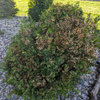Clerodendron chlorosis
gardengal48 (PNW Z8/9)
18 years ago
I posted this in my regional forum but didn't get any responses - perhaps a broader audience can offer some suggestions.
I have a fairly mature Clerodendron trichotomum that blooms profusely but in the last couple of growing seasons seems to suffer late in the season (like now) from leaf chlorosis. None of the other plants in the garden have displayed any sign of chlorosis, including those which are prone to iron deficiencies in slightly acidic soils. Is this just a lack of iron or should I be looking at other causes? Apart from the chlorosis, the plant seems to be thriving with considerable new growth and plentiful flowers (and very little suckering). And no, I have not tested my soil - since nothing like this has cropped up before, I have never had the need.

Treedoc66
Ron_B
Treedoc66
Ron_B
jean001
gardengal48 (PNW Z8/9)Original Author
viburnumvalley
gardengal48 (PNW Z8/9)Original Author
Treedoc66
viburnumvalley
Ron_B
jean001
gardengal48 (PNW Z8/9)Original Author
Treedoc66
Ron_B
susanlynne48
Treedoc66
gardengal48 (PNW Z8/9)Original Author
dwk001
Treedoc66
gardengal48 (PNW Z8/9)Original Author
peter_bowles_lycos_co_uk